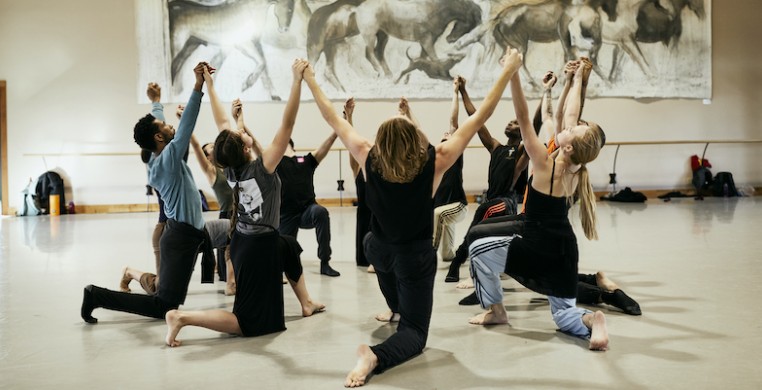Editor's note: This preview was commissioned by the JOMBA! Contemporary Dance Experience and is co-published in English and isiZulu on the JOMBA! festival blog.
COVID-19 and quarantine, specifically, continue to shed light on social injustices that exist in our world. Access to money, technology, medical supplies and research have all informed the race to combat a virus that has changed how we live our lives to the core. Despite it all, I’ve noticed that being forced to stay in one place has sparked an awakening of sorts. More people than ever before are observing and digesting the imbalance that has always existed. Social media platforms like Tik-Tok and Instagram are flooded with new forms of advocacy and allyship—I’m happy to see the impact my generation is having on the world. But looking back, The Limón Dance Company, among others, has always strived to combat social inequities through dance.
Founded in 1946 by Jose Limón and his dance partner, Doris Humphrey—a founding mother of American modern dance—the company is known for its cutting, passionate and breath-driven choreography. Today they are considered an influential staple in both their home-base of New York and in the global dance scene. Though Limón passed away in 1972, his legacy lives on through the study of his codified technique, a National Medal of the Arts worthy foundation and the company, who pays tribute to his choreographic excellence in addition to supporting impactful emerging choreographers. The company deftly walks the line between past and present, and on Friday I encourage viewers to open their computers to watch the balancing act in action as part of the 23rd edition of the JOMBA! Contemporary Dance Experience.
Three works—two pay homage, one, of today. “The Moor’s Pavane” and “There is a Time” are straight from the mind of Limón himself, while “Suite Donuts” is from up-and-coming choreographer Chafin Seymour. Current Artistic Director, Dante Puleio, pays homage to Limón perfectly with this curation of works, as well as paints an accurate portrayal of the contemporary lifestyles we live today.
Virtual audience members will fall in love with “Suite Donuts,” a work that nods at D.J. J. Dilla’s final masterpiece via a classical lens. Soft horns and subtle violins embody what would be drum kits and synthesizers, as monochromatic sweat pant-clad dancers gesture and move throughout the stage. J. Dilla, affectionately referred to as the “Mozart of Hip Hop,” was a beloved part of the classical music community. Seymour pays tribute to his musical excellence with his work that premiered in June 2020. The overt release technique inspired piece—a style of dance rooted in the exploration and connection between gravity, breath, and the body—blends contemporary with hip-hop dance seamlessly. Think rock steps into inversions or a step-touch into a floor roll. Seymour uses the seven dancers wisely, and viewers will get lost in his juxtaposition of stillness with movement, as well as the playful energy the dancers give off.
Limón’s Othello-inspired—an important distinction as he was emphatic it was not an interpretation— work, “The Moor’s Pavane” will feel like a retrograde through time, choreographically speaking. The program’s shift from modern-contemporary to historical American modern dance is abrupt yet satisfying, and the societally unjust underpinnings of the storyline are more relevant than ever today. The quartet of company dancers, dressed in the most medieval of costumes, execute a fall-and-release-influenced Pavane, which historically speaking is a stately and sedate court dance for couples. Undeniably profound for its 1949 premiere—and even more so for being one of the first major works produced by the company— “The Moor’s Pavane” connects wealth, lies and deceit with technically perfect attitudes and strikingly emotional gestures. All while effectively reiterating the moral of the tortured story—don’t lose the handkerchief!
The final work in the set of three, “There is a Time,” is an ode to cyclical movement, both in the body and spatial patterns. The dance is filled with lilting port de bras and languid rond de jambes that evoke a peaceful, almost hypnotized feeling. The grandiose musical swells are easy to get lost in. Audiences can enjoy the smoothest of performance qualities for the entirety of the 45-minute piece. “There is a Time” has the dramatic qualities of a Martha Graham piece (one of Limon’s American contemporaries)—typically rooted in Greek tragedy and enhanced by hard contractions with over-the-top eyeliner—but very contemporary movement. I found the floorwork and upper body carriage to be remarkably familiar to the modern classes I take today, with the feminine partner often guiding.
Aggregately, these pieces feel fresh despite the fact they run the gamut in terms of premiere dates—the last piece on the programme being from 1956. Each one is inspiring in their own right, a term I don’t use lightly due its heavy usage and propensity for tokenism. As I sat at my kitchen table, slowly falling in love with the Limón company dancers, I did feel inspired: Inspired to create work of my own, to dance like they dance, and perform with a fearlessness that is contagious. The dancers are larger than life. Watching their effortless performance and picturesque technique will be heart-swelling for any dance lover, let alone an attendee of the JOMBA! Contemporary Dance Experience.
--
The Limón Dance Company appears Friday, Aug. 27 at noon, CST as part of the JOMBA! Contemporary Dance Experience. The festival continues with daily shows online through Sept. 5. For more information and to access the performances, visit jomba.ukzn.ac.za.

